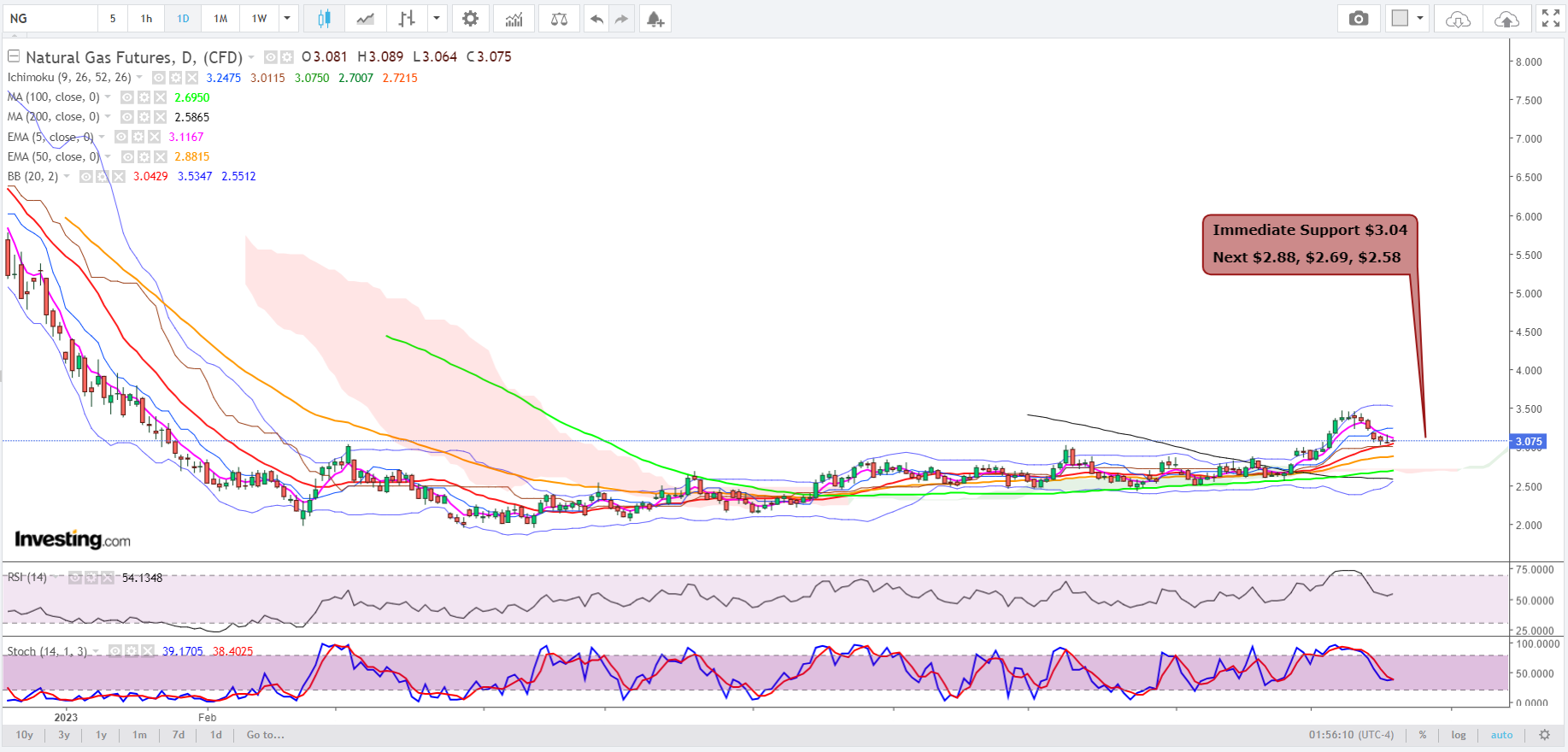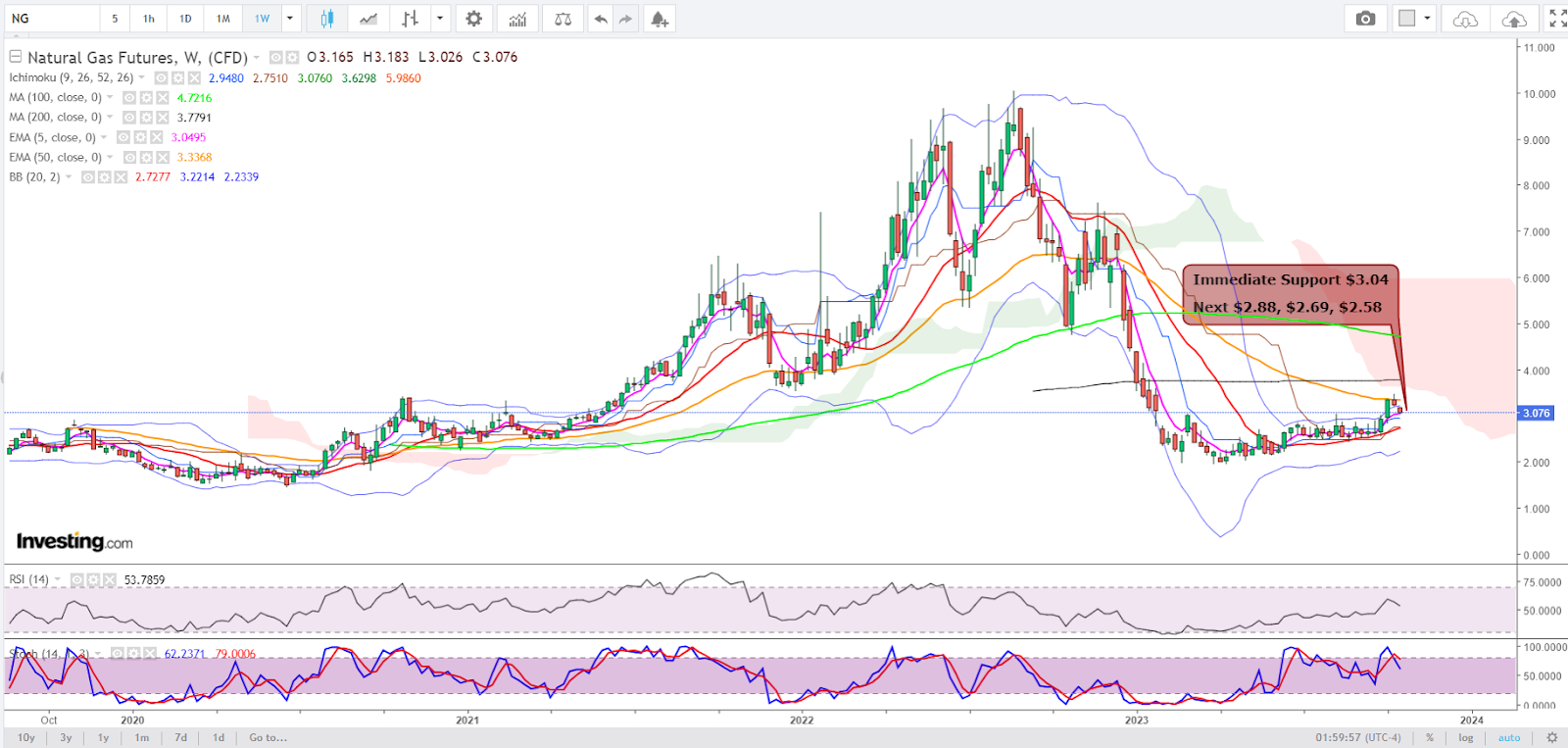- Henry Hub’s front-month swoons to $3.07 from $3.47 peak last seen in January
- Charts suggest interim return to $2 pricing but bulls refute that, pointing to demand
- Below-normal 80-bcf storage build forecast for last week due to higher consumption
From 8-½ month highs of nearly $3.50, US natural gas is clinging to low $3s now after a mini crash over two weeks.
But fret not as LNG demand is here, say bulls in the game.
Most commentators will tell you it’s a different gas market today than the one that was wallowing at mid-$2 for months — after an unbelievably warm winter for 2022/23, followed by all-time highs in daily production and a summer that despite seeing record heat on many days did not translate to runaway demand for LNG, or liquefied natural gas.
Those familiar with the nuances of the global LNG market will also tell you that pricing fundamentals were weakened by steep demand reductions in Europe and a maturing of Asian markets. As such in the first three quarters of the year, European hub and Asian spot LNG prices averaged 70% and 60% below their 2022 levels, respectively.
Adding to that, a six-day swoon from $3.471 per mmBtu, or million metric British thermal units, to $3.07 (at the time of writing) on the New York Mercantile Exchange’s Henry Hub has also damaged somewhat the technical optics of the front-month November contract.  Charts by SKCharting.com, with data powered by Investing.com
Charts by SKCharting.com, with data powered by Investing.com
Is Gas Returning to $2? Charts Say Likely But Gas Bulls Refute That
Says Sunil Kumar Dixit, chief technical strategist at SKCharting.com:
“The 50-week EMA, or Exponential Moving Average, of $3.34 is a significant barrier to clear if the gas market is to reacquire its mojo of the past month.”
If gas bulls fail to bust that resistance, profit booking on the mid-September to early-October rally in gas could push prices to support areas, now hovering at the 5-week EMA of $3.04, said Dixit.
He adds:
“Once this zone is broken, expect a further drop to the Weekly Middle Bollinger Band of $2.72.”
“But value-seeking buyers are also likely to surface at that point, resuming the uptrend that could see us $3.34. If that goes without too much trouble, then the next leg higher would be the 200-week SMA, or Simple Moving Average, of $3.78.”
The return to $2 pricing may also be avoided if LNG demand, which some are counting on, emerges with impact.
‘Robust’ Demand
LNG demand is “robust, with the seven-day average climbing above 100 Bcf/week for the first time since April,” EBW Analytics Group senior analyst Eli Rubin said in comments carried by industry portal naturalgasintel.com.
Repair and upgrade work culminated at multiple export facilities in recent days, bringing capacity back online and boosting feed gas demand, Rubin noted, adding that buyers in Europe and Asia were also fortifying supplies and calling for US LNG ahead of winter.
However, supplies of LNG out of Australia, in question amid recent threats of a strike at two Chevron (NYSE:CVX) export plants, looked less vulnerable after labor unions late Tuesday halted plans to walk off the job.
Offshore Alliance, which represents unions, said workers accepted Chevron’s proposed settlement on improved compensation and working conditions. Concerns about supply interruptions in Australia had raised concerns about shortages and sent European prices surging in recent sessions.
StoneX Financial's senior vice president of energy Thomas Saal says:
“We’ve got a lot of moving parts right now, and I think the market is seeing balance, with LNG strong but production also robust.”
“That’s keeping futures in check until we actually see that colder weather settle in and really drive heating demand.”
Gas futures on the Henry Hub did find fresh footing early Wednesday, rising 8.0 cents in morning trading, before reversing to close lower as output hovered at around 102.5 billion cubic feet per day and near record levels of above 103 bcf/d reached earlier in the week, as per Bloomberg estimates. Maintenance work in the Permian Basin, the engine of recent volume gains, triggered the modest downward production revision.
Further on the demand side, NatGasWeather said forecasts Wednesday showed that following light national demand through Saturday, a “bump” in consumption is expected beginning this weekend and continuing through the first two trading sessions of next week as cool air blows through the Great Lakes and Northeast. Both are key gas-consuming regions.
Further out, much of the East should see seasonal conditions over the final days of October, but swaths of the West, from the Rockies to the Pacific Northwest, could see multiple cool shots, the firm said. Broader bouts of cold are expected in November.
EBW Analytics Group estimated increased cumulative natural gas demand compared to expectations to start the week. This reflected a combination of supportive heating demand trends and “increases in power sector coal-to-gas switching” over the coming weeks on lower natural gas prices, according to senior analyst Rubin.
NatGasWeather said much of the country would warm to near or above-normal high temperatures between Wednesday and Saturday, creating mild conditions and dampening demand.
But the firm said a weather system over the Rocky Mountains and Midwest could “tap colder Canadian air and track across the Great Lakes and Northeast Sunday-Tuesday, with showers and highs of the upper 40s and 50s,” galvanizing heating demand that could offset comfortable conditions elsewhere.
Another “cool shot will sweep across the northern US Oct. 29-31, with (temperature) highs of 40s-50s (Fahrenheit),” ushering in more demand.
Below Average Weekly Storage Build Seen
Ahead of the US government’s weekly update on natural gas storage, a Reuters poll estimated that utilities likely added a below-average 80 bcf to inventories last week, a Reuters poll.
That would be lower than the 113 bcf injected during the same week a year ago and the five-year (2018-2022) average increase of 85 bcf for this time of year.
In the week ended Oct. 6, utilities added 84 bcf of gas into storage.
The forecast for the week ended Oct. 13 would lift stockpiles to 3.609 trillion cubic feet, (tcf), 8.5% above the same week a year ago and 4.6% above the five-year average.
There were 63 TDDs, or total degree days, last week compared with a 30-year normal of 68 TDDs for the period, data from LSEG showed.
TDDs measure the number of degrees a day's average temperature is above or below 65 degrees Fahrenheit (18 Celsius) to estimate demand to cool or heat homes and businesses.
***
Disclaimer: The aim of this article is purely to inform and does not in any way represent an inducement or recommendation to buy or sell any commodity or its related securities. The author Barani Krishnan does not hold a position in the commodities and securities he writes about. He typically uses a range of views outside his own to bring diversity to his analysis of any market. For neutrality, he sometimes presents contrarian views and market variables.
